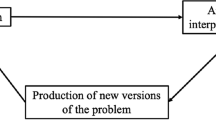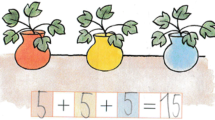Abstract
The study presented in this paper seeks to investigate the impact of authenticity on the students’ disposition to make necessary real world considerations in their word problem solving. The aim is also to gather information about the extent to which different reasons for the students’ behaviors are responsible for not providing solutions that are consistent with the ‘real’ situations described in the word problems. The study includes both written solutions to word problems and interview data from 161 5th graders. The results show an impact of authenticity on both the presence of ‘real life’ considerations in the solution process and on the proportion of written solutions that were really affected by these considerations. The students’ frequent use of superficial solution strategies and their beliefs about mathematical word problem solving were found to be the main reasons for providing solutions that are inconsistent with the situations described in the word problems.
Similar content being viewed by others
References
Brousseau, G. (1997). Theory of didactical situations in mathematics. Dordrecht: Kluwer.
Carpenter, T. P., Lindquist, M. M., Matthews, W., & Silver, E. A. (1983). Results of the third NAEP mathematics assessment: Secondary school. Mathematics Teacher, 76, 652–659.
Cooper, B., & Dunne, M. (2000). Assessing children’s mathematical knowledge: Social class, sex and problem-solving. Buckingham: Open University Press.
Cooper, B., & Harries, T. (2002). Children’s responses to contrasting ‘realistic’ mathematics problems: Just how realistic are children ready to be? Educational Studies in Mathematics, 49, 1–23.
Cooper, B., & Harries, T. (2003). Children’s use of realistic considerations in problem solving: Some English evidence. Journal of Mathematical Behavior, 22, 451–465.
Davis, R. B. (1989). The culture of mathematics and the culture of schools. Journal of Mathematical Behavior, 8, 143–160.
DeFranco, T. C., & Curcio, F. R. (1997). A division problem with remainder embedded across two contexts: Children’s solutions in restrictive vs. real-world settings. Focus on Learning Problems in Mathematics, 19(2), 58–72.
Fitzpatrick, R., & Morrison, E. J. (1971). Performance and product evaluation. In R. L. Thorndike (Ed.), Educational measurement, (2nd ed.) (pp. 237–270). Washington, DC: American Council on Education.
Greer, B. (1993). The modeling perspective on wor(l)d problems. Journal of Mathematical Behavior, 12, 239–250.
Greer, B. (1997). Modelling reality in mathematics classrooms: The case of word problems. Learning and Instruction, 7, 293–397.
Inoue, N. (2005). The realistic reasons behind unrealistic solutions: The role of interpretive activity in word problem solving. Learning and Instruction, 15, 69–83.
Lithner, J. (2000). Mathematical reasoning in task solving. Educational Studies in Mathematics, 41, 165–190.
Maier, E. (1991). Folk mathematics. In M. Harris (Ed.), School, mathematics and work. Basingstoke: Falmer Press.
Palm, T. (2002). The realism of mathematical school tasks – Features and consequences, Doctoral dissertation, Department of Mathematics, Umeå University, Sweden.
Palm, T. (2006). Word problems as simulations of real-world situations: A proposed framework. For the Learning of Mathematics, 26(1), 42–47.
Reusser, K., & Stebler, R. (1997a). Every word problem has a solution – The social rationality of mathematical modeling in schools. Learning and Instruction, 7(4), 309–327.
Reusser, K., & Stebler, R. (1997b). Realistic mathematical modeling through the solving of performance tasks. In Seventh European Conference on Learning and Instruction, Athens, Greece.
Säljö, R., & Wyndhamn, J. (1993). Solving everyday problems in the formal setting: An empirical study of the school as context for thought. In S. Chaiklin & J. Lave (Eds.), Understanding practice: Perspectives on activity and context (pp. 327–342). Cambridge: Cambridge University Press.
Verschaffel, L., & De Corte, E. (1997). Teaching realistic mathematical modeling in the elementary school: A teaching experiment with fifth graders. Journal for Research in Mathematics Education, 28(5), 577–601.
Verschaffel, L., De Corte, E., & Lasure, S. (1994). Realistic considerations in mathematical modeling of school arithmetic word problems. Learning and Instruction, 22(4), 273–294.
Verschaffel, L., De Corte, E., & Lasure, S. (1999). Children’s conceptions about the role of real-world knowledge in mathematical modeling of school word problems. In W. Schnotz, S. Vosniadou, & M. Carretero (Eds.), New perspectives on conceptual change (pp. 175–189). Oxford: Elsevier.
Verschaffel, L., Greer, B., & De Corte, E. (2000). Making sense of word problems. Lisse, The Netherlands: Swets & Zeitlinger.
Yoshida, H., Verschaffel, L., & De Corte, E. (1997). Realistic considerations in solving problematic word problems: Do Japanese and Belgian children have the same difficulties? Learning and Instruction, 7(4), 329–338.
Acknowledgements
The author wishes to thank Hans Wallin and Johan Lithner for their valuable comments on an earlier version of this paper.
Author information
Authors and Affiliations
Corresponding author
Rights and permissions
About this article
Cite this article
Palm, T. Impact of authenticity on sense making in word problem solving. Educ Stud Math 67, 37–58 (2008). https://doi.org/10.1007/s10649-007-9083-3
Received:
Accepted:
Published:
Issue Date:
DOI: https://doi.org/10.1007/s10649-007-9083-3




